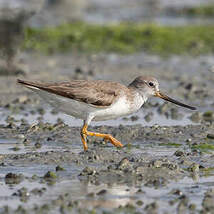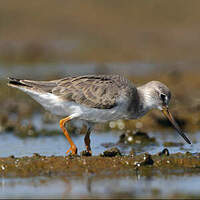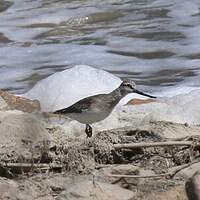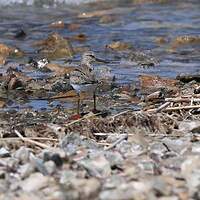Terek Sandpiper
Xenus cinereus - Chevalier bargette
Identification
The Terek Sandpiper is the only small wader with short legs that has an upcurved bill. It is coloured yellow at the base. The bird runs with a bent forward posture and its forehead is steep.
Its plumage is quite neutral - white on the belly and a drab grey on the top with black spots particularly on the scapulars, forming a V. The wrist presents a dark spot. The cap, neck, cheeks and sides of the chest are streaked. The white eyebrow is sharper in front of the eye and is outlined by a thin dark loral line. The relatively short legs are yellowish or yellow-orange.
In winter plumage the upper parts are paler and generally do not have black stripes. The chest is paler and the stripes are very reduced.
Juveniles have darker and browner upperparts than adults. The feathers have a chamois edging and a dark subterminal line.
Subspecific information monotypic species
Foreign names
- Chevalier bargette,
- Andarríos del Terek,
- maçarico-sovela,
- Terekwasserläufer,
- terekcankó,
- Terekruiter,
- Piro piro del Terek,
- tereksnäppa,
- Tereksnipe,
- brodník sivý,
- vodouš malý,
- Terekklire,
- rantakurvi,
- Terekruiter,
- siseta cendrosa,
- Bjúgstelkur,
- terekia,
- terekija,
- sabljasti martinec,
- Мородунка,
- Trinil bedaran,
- ソリハシシギ,
- 翘嘴鹬,
- นกชายเลนปากแอ่น,
- 反嘴鷸〔翹嘴鷸〕,
Voice song and call
Habitat
Behaviour character trait
The Terek Sandpiper is extremely active. Its head and tail wagging is reminiscent of the Common Sandpiper.
It feeds in the wetlands, moving quickly and erratically. It probes in the mud and can pursue its prey. It also occasionally dives down into shallow water to catch it. It swings its head horizontally from side to side in the water, to search for food, in the same way as the Avocet. Its curved bill is well adapted to this fishing technique. It fishes alone or in small groups, often mixed with other waders. The Terek Sandpiper seems to be monogamous. It is a long distance migratory bird.Dietfeeding habits
Reproduction nesting
Although the Terek Sandpiper is territorial, it nests in loose colonies, often with other sandpipers.
It builds its nest near water, in wet meadows, in taiga or on sandy or muddy riverbanks. The nest is basically a shallow depression lined with small pebbles and coarsely lined with dry grasses, driftwood, and various vegetable debris. The site it chooses is an open one with low vegetation. On alternate days the female will lay 3-4 eggs in the nest, spotted with brown-red and brown-black on a gray-green background. Incubation, lasting about 24 days, is shared with the male. The male will take sole responsibility for the chicks a few days after hatching. On top, the chicks are grayish brown or dirty gray with fine spots or dark stripes. The lower parts, chin and throat are white. A black line runs from the crown and extends to the back.Geographic range
Threats - protection
IUCN conservation status
concern
in the Wild
threatened
evaluated
Its wintering habitat is shrinking due to the development of tourism and agriculture. Human activities and pollution are contributing to the degradation or destruction of the habitats that are favourable to it. Frequent disturbances caused by recreational development are harmful to the species.
Sources of information
- IOC World Bird List (v15.1), Gill, F and D Donsker (Eds). 2025-12-07.
- Guide des limicoles d'Europe, d'Asie et d'Amérique du Nord, D. Taylor
- Le guide ornitho : Le guide le plus complet des oiseaux d'Europe, d'Afrique du Nord et du Moyen-Orient : 900 espèces, Svensson, Mullarney, Zetterstrom
- Avibase, Lepage Denis
Other sources of interest
 Specification sheet created on
03/08/2023 by Jean-Pierre Trouillas
Specification sheet created on
03/08/2023 by Jean-Pierre TrouillasTranslation by AI Oiseaux.net
© 1996-2025 Oiseaux.net
- Accipitriformes
- Aegotheliformes
- Anseriformes
- Apodiformes
- Apterygiformes
- Bucerotiformes
- Caprimulgiformes
- Cariamiformes
- Casuariiformes
- Charadriiformes
- Ciconiiformes
- Coliiformes
- Columbiformes
- Coraciiformes
- Cuculiformes
- Eurypygiformes
- Falconiformes
- Galliformes
- Gaviiformes
- Gruiformes
- Leptosomiformes
- Mesitornithiformes
- Musophagiformes
- Nyctibiiformes
- Opisthocomiformes
- Otidiformes
- Passeriformes
- Pelecaniformes
- Phaethontiformes
- Phoenicopteriformes
- Piciformes
- Podargiformes
- Podicipediformes
- Procellariiformes
- Psittaciformes
- Pterocliformes
- Rheiformes
- Sphenisciformes
- Steatornithiformes
- Strigiformes
- Struthioniformes
- Suliformes
- Tinamiformes
- Trogoniformes




























